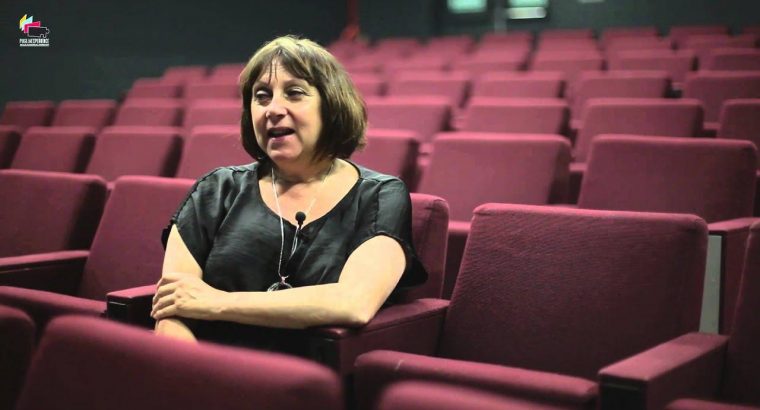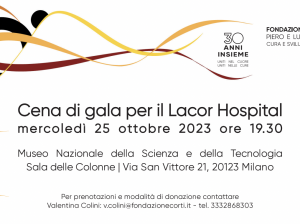Writing for Stage and Screen: English Theatre Milan Masterclass with Ann Marie Di Mambro
English Theatre Milan recently organised an online Masterclass “Writing For Theatre And Television” led by the acclaimed Scottish theatre and TV dramatist Ann Marie Di Mambro, who explained the differences between writing for the two media, as well as film.
About the speaker
Ann Marie Di Mambro is a fine theatrical storyteller who deftly mixes tragedy and comedy with moments of highly charged theatricality and quiet introspection. As an acclaimed writer with over a hundred TV credits, her work has included countless episodes for popular television drama series, including High Road, EastEnders, Casualty, River City, The Coroner and Eve, etc. She started as a theatre writer before moving on to television but has stayed active in the theatre throughout her career. Her stage play Tally’s Blood is on the Scottish school exam syllabus. This seminal work explores the story of Italian migration to Scotland, with a focus on one particular family (based on Ann Marie’s own). She is currently working on two plays, one with the Glasgow-based company, Witsherface, the all-female, grass roots comedy movement fronted by Karen Dunbar (Chewing the Fat), Elaine Mackenzie Ellis (Rab C Nesbitt), and Maureen Carr (Still Game). (Maureen also directed Rose Reilly, Footballer, which featured recently in English Theatre Milan’s pocket season at the Teatro Gerolamo.) Ann Marie Di Mambro is a Professor at Glasgow Caledonian University, lecturing in Television Fiction Writing.
This English Theatre Milan Masterclass provided a fascinating opportunity to hear from one of the UK’s most experienced TV writers about the differences between writing for live theatre and dramas created for television as well as cinema.
About the Masterclass
Introduction: How Ann Marie got started as a writer and her approach to writing
Maggie Rose of EMT introduced Ann Marie, who started by talking about her life, especially her connection with Italy. Her family is originally from a tiny village near Naples although they moved to Scotland, where Ann Marie grew up. Her father worked in the archetypal business of Italian migrants, selling ice-cream. (The title of her play Tally’s Blood is a reference to the somewhat offensive Scottish slang term for the strawberry sauce poured over ice-cream: Tally = Italian.) However, far from being a stereotype, Ann Marie’s father was an exceptional man for his generation and wanted all six of his children, daughters included, to study. In fact, he was one of many Italians who were extremely poor when they arrived in Scotland in the 1920s and ‘30s but who made an outstanding career for themselves. Many, including those from the Salerno province of Italy, became famous restaurant owners, businessmen and ice-cream makers: genuine rags to riches stories. Most of them believed in education and their children have done even better for themselves.
Ann Marie told the group (which met via Zoom) that anyone in the world can write. She herself started writing plays for theatre when she was a teacher, 30 years ago. Serendipity played a part in her story when she met a young woman who was also writing plays. They created their own theatre group for new writing by doing showcase productions, with actors and directors sharing profits. This led to her receiving her first official commission for TV drama.
Talking about her own writing, Ann Marie said that she has a very naturalistic style of writing, creating characters who communicate with each other in an unforced, authentic way. Although she admires highly stylised writing, that is not her approach. She never studied drama formally; she simply loved writing. Early criticism of her work came from a woman with a word processor who used to charge writers for typing up their manuscripts; in fact, she was the first person to read the work done by Ann Marie, who was desperate for feedback. Despite her reluctance, the typist agreed, although her reaction was not really what Ann Marie was expecting: “How can you stand writing this stuff?” she asked. The typist told her that she was writing a novel and could describe the room her characters were in, what they’re wearing, etc. All Ann Marie had to work with was the characters she had created and the dialogue they speak, so she actually took the typist’s remark as a compliment, however backhanded.

Writing dialogue
According to Ann Marie, it’s all the things you don’t put on the page that make it drama: drama is character and dialogue. She said that if she could sum up writing drama in one sentence, it would be that it’s what happens between people at an emotional level – and not much else.
However, while both theatre and TV are in the business of creating characters that speak to each other, there are some clear differences. On television, for example, you can do close-ups, allowing you (literally) to “see the whites of the characters’ eyes” and focus on detail that would be missed on stage (e.g. slipping a pill into someone’s drink). Dialogue on TV is characteristically sparse and pared down: there’s just less of it compared to theatre. You don’t really get monologues in TV drama: anything more than 8 lines gets cut. Television is also more naturalistic, although it can also use special effects.
Ann Marie said that she is a drama writer: poetry or novelistic prose is not her thing. In one of her many intriguing observations in the Masterclass, she said that while most people know they may not be a poet or novelist, they don’t necessarily know that they can’t write dialogue. Dialogue writing looks easy but isn’t: the writer has to be “sly”, sculpting the lines – and they need to know what they’re doing. Naturalistic dialogue has to say something in as few words as possible, creating space for the viewer or spectator without telling them everything.
“I don’t know that much but what I do know, I know well,” said Ann Marie.
Referring to Highroad, a Scottish soap opera about a farming community, which Ann Marie wrote for, she described a scene where a widowed farmer has plucked up courage to ask his girlfriend if she will share bed. She starts criticising the wallpaper in bedroom, asking him “Do you expect me to sleep in room like this?” Her criticism of the wallpaper is actually her way of saying “yes”. So, here again, the dialogue itself is not what the scene is about: it’s not about wallpaper at all but rather about navigating a critical stage in the relationship between the two characters.
Ann Marie summed up writing dialogue with a number of key points, including some quotes:
Dialogue is best understood through what it’s not. It’s not conversation, although it seems like it. In fact, an actual conversation in a restaurant or pub would be really boring. It’s not information, although it has to convey information, for example about the characters, and move the plot forward, but if all that it’s doing, then it’s not dialogue. Ann Marie cringes when she hears lines that are purely informative, e.g. someone saying “Well I know I’m your sister but…”. Clunky. If you’re giving information, you need to disguise what you’re doing.
Dramatic dialogue is not meant to be literary or poetic. Good dramatic dialogue is about making an impact, not just saying something beautiful. She cites David Mamet: a dramatic line should land on an audience, while a literary line goes over their heads. The line might not mean anything in itself.
Dialogue is not the first thing you write: it comes late in the process. Get the story and the characters right before you let them talk. This is essential for TV.
You need a solid structure for teleplay, not just an outline. You will be asked for a story written out in detail. Decide which scene goes where before you deliver your script.
Referring to a remark by the great film director, Sir Alfred Hitchcock, Ann Marie drew an interesting distinction between a screenplay and dialogue. Hitchcock mentioned that when a screenplay had been written, the dialogue was added. Dialogue, therefore, is usually something that comes later, after you have determined your characters and story.
Practical example
In this section of the Masterclass, Ann Marie took us through a “scene by scene”, breaking down an extract from a well-known film in order to understand how the dialogue works in it. (We were also asked to guess where the was from. In fact, it was from the 1987 blockbuster Fatal Attraction, starring Michael Douglas and Glenn Close – although not many people recognised the source, for reasons that will become apparent.)
In the scene we analysed, Dan, a businessman (Michael Douglas), comes home from work where his wife is with a potential buyer for their house, which they have on the market. The prospective purchaser, of course, is Alex (Glenn Close), obsessed with the man she shared a one-night stand with, who has subsequently cooled. Close’s character gave rise to the expression “bunny boiler”. (If you’ve seen the film, you’ll know why.)
We read through the scene, with two of the participants reading the script, and watched it on YouTube as well. Ann Marie led us through the episode, drawing out from the participants how the surface dialogue has virtually nothing to do with what’s actually happening. Superficially, the scene is about viewing a new house, but picking up on Ann Marie’s earlier points, it’s what isn’t said that makes this scene so powerful.
The scene makes brilliant use of close-ups, notably on Douglas’s face and his perplexity as he is caught (to continue the leporine theme) like a rabbit in the headlights. There is also a close-up on Dan and Alex’s awkward handshake.
What’s really happening in the scene is expressed mainly through Michael Douglas’s silence and the suppressed horror that we see in his eyes. Alex is ice cool, obviously relishing his discomfort. She also drops a bombshell in a chance remark about being pregnant.
According to Ann Marie, there is a balance in the scene between silence and language. The chit-chat about that house and its advantages belies the extreme emotion of Close confronting Douglas in his own home and in front of his wife, who has no idea about the true relationship between her husband and the vistor.
Director Adrian Lyne handles the scene perfectly. Ann Marie points out that there is very little in the way of stage directions in the screenplay. In general, directors dislike being told how to direct by the writer: writers write and directors direct.
Alex (Close) is in charge of the scene throughout. Douglas has been blindsided but can’t say anything: the audience are invited to watch him squirm as his wife blithely gives away key information, such as their intended move to the country. Referring to Ann Marie’s earlier remark about the line landing on the audience, this technique is used to perfection here.
In drama, character and dialogue connected to each other. As the writer, you have to create the people who are going to speak, Ann Marie (who teaches writing for TV one day a week) explains that creating characters is deceptive. It looks easy but isn’t. Character does not mean a biography. Having a name and traits is not enough. The characters have to actually do something. You don’t need a half-page background for a character; the trick is to find something interesting about them. Also, you will get to know your characters by writing for them. Ann Marie also shared some practical tips, for example, don’t have two characters doing the same job dramatically: instead, combine them into a single character.
Tally’s Blood
For the second of her two examples, Ann Marie chose a scene from her own play, Tally’s Blood, which is based on stories told by parents. In the play, Rosinella is a woman who has moved to Scotland. Her husband is Massimo. Rosinella’s sister has died in Italy and her baby, Lucia, now 5 is being brought up by her sister and her brother-in-law in Scotland. They have a café in Glasgow, which serves homemade ice-cream. The scene follows a shopping trip to the city. Ann Marie asked the participants to identify the choices that are made in the scene, a key moment of which involves asking Lucia to change out of her new dress, which she refuses to do. (Dana Rufolo, Editor in chief of Plays International & Europe theatre magazine, one of the participants at the masterclass, gave a great impromptu performance of the stroppy Lucia.) The scene contains quite a lot of Scots / Glaswegian terms, for example at one point Massimo justifies Lucia’s resistance (or stubbornness) with the observation that “She’s just a wean”, i.e. she’s just a child. The play progresses around the relationship between Rosinella and Lucia. Is Lucia loved? During the scene, a big choice is made.
Tally’s Blood draws heavily on the experiences of Ann Marie’s own family. During the post-war period, poverty was a reality: for example, when her mother returned to Italy, she would leave the contents of her suitcase with people in village. Giving back to your community was a big thing that meant a lot. When her mother got some money, she bought jumpers for people back home (a fact which she includes in this scene).
According to Ann Marie, in a drama the characters must go on a journey, they must change. The best example of this from contemporary writing for TV is the Netflix hit Breaking Bad. In the show, we accompany the character of Walter White on his journey from a decent man to a bad one (as referenced in the title) as he reacts to the circumstances he finds himself in and the choices he makes.
Ann Marie: Always ask yourself: what is your character’s journey? What is story arc for your character? A good way of understanding this is to ask yourself “What do your characters want?” For example, in Tally’s blood Rosinella wants to keep Lucia, not just to look after her.
When World War II breaks out, Italy sides with Germany. Lucia ends up staying in Italy until she’s 18. Rosinella doesn’t want her to return to her father in Italy. However, often what a character needs is more important than what they want. The character’s journey involves getting what they need. Rosinella needs to let Lucia go.
Rosinella develops resentment bordering on prejudice to people in Scotland because of what happens to her husband, Massimo, during the war. Italians were interned in Scotland (and sent to other countries including Canada and Australia), something which happened to Ann Marie’s father. The family’s café was ransacked by looters. Rosinella needs to let all the bitterness go and she reacts badly when Lucia starts going out with a Scottish boy, although eventually she helps Lucia establish a relationship as she comes to forgive Scottish people for what happened.
In another scene from the play, we see Lucia with Hughie, a little kid from a mining community whose father is killed in an accident. Why does Hughie care so much about Lucia, who is a something of a spoilt brat and has a tendency to speak Italian at school, and who actually bosses him about? However, in another scene in the play, she says it’s OK to cry: Scottish men are brought up not to cry.
Conclusion of the course Masterclass
At the end of the Masterclass, Maggie Rose thanked Ann Marie Di Mambro for her fascinating insights into the craft of the drama writer – both for theatre and TV – and for sharing her inspiring approach to writing. Maggie’s sentiments were echoed by all the participants, myself included.
Upcoming Masterclasses by ETM
English Theatre Milan are currently organising an exciting series of events for the autumn. Stay up to date with all the latest ETM news by signing up for the Easy Milano newsletter or from their website, englishtheatremilan.org.
Article by Robert Dennis, EasyMilano
Images:
Ann Marie Di Mambro (Image: Puglia Experience, Alchetron)
Tally’s Blood by Ann Marie Di Mambro (Image: Hodder Gibson)
About the author
Robert Dennis is a writer and Business English teacher based in Milan. He has been teaching for other 30 years both in the UK and in Italy. A long-time collaborator with John Peter Sloan, Robert published Business English (Gribaudo) in 2020. The book was launched with “Il Sole 24 Ore” and sold in newsstands throughout Italy. Robert has a website for people who want to learn Business English: Pay As You Learn.com. The site features keywords and phrases, audio and exercises to help professionals improve their language skills. A graduate in English from Oxford University, Robert is a regular contributor to Easy Milano who often writes about plays staged in English in Milan and other cultural events in the city. He is also a translator and “buongustaio” who loves Italian food!
Easy Milano
Easy Milano is the online publication for the international community of Milan. We offer practical tips, key information and essential insights about living and working in Italy. Easy Milano has been assisting English speaking expats in Milan since 1999.
Follow us on Facebook - Instagram - Newsletter
You must be logged in to post a comment.




